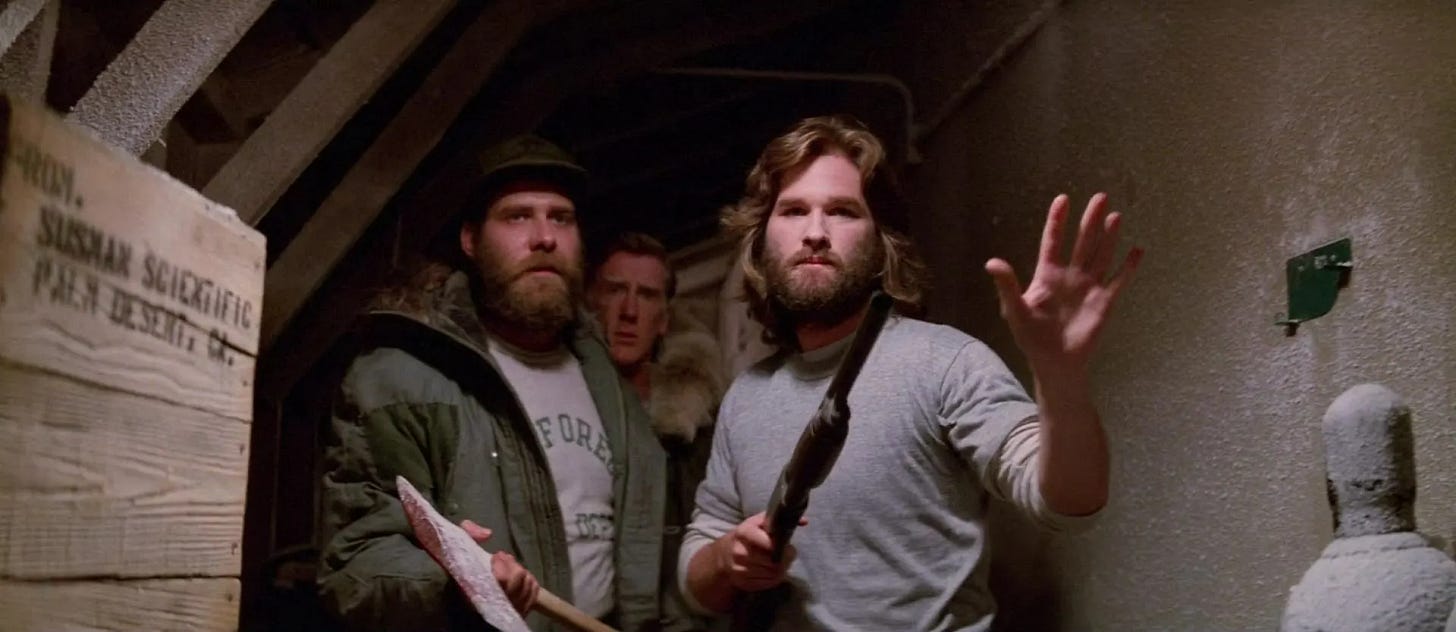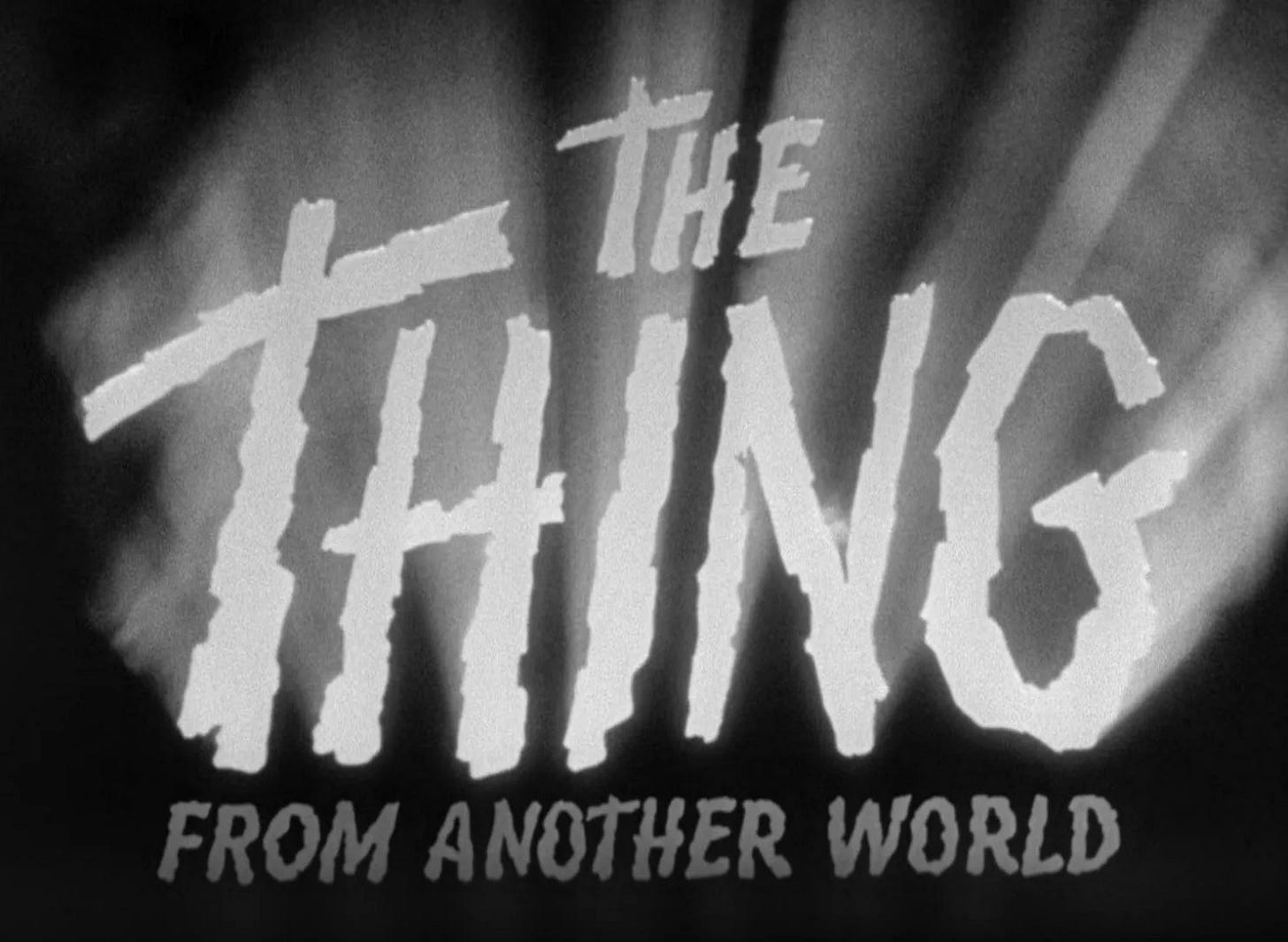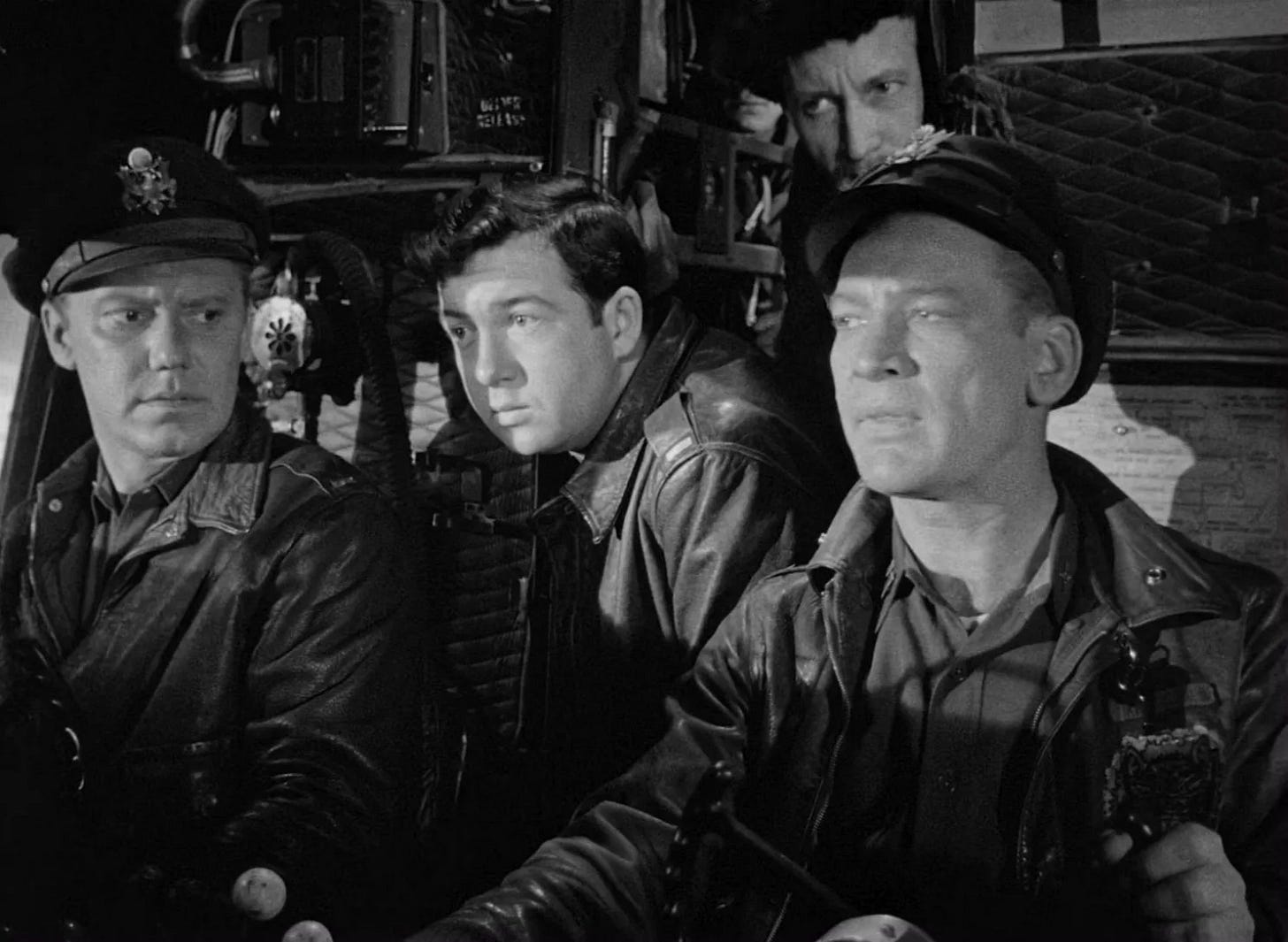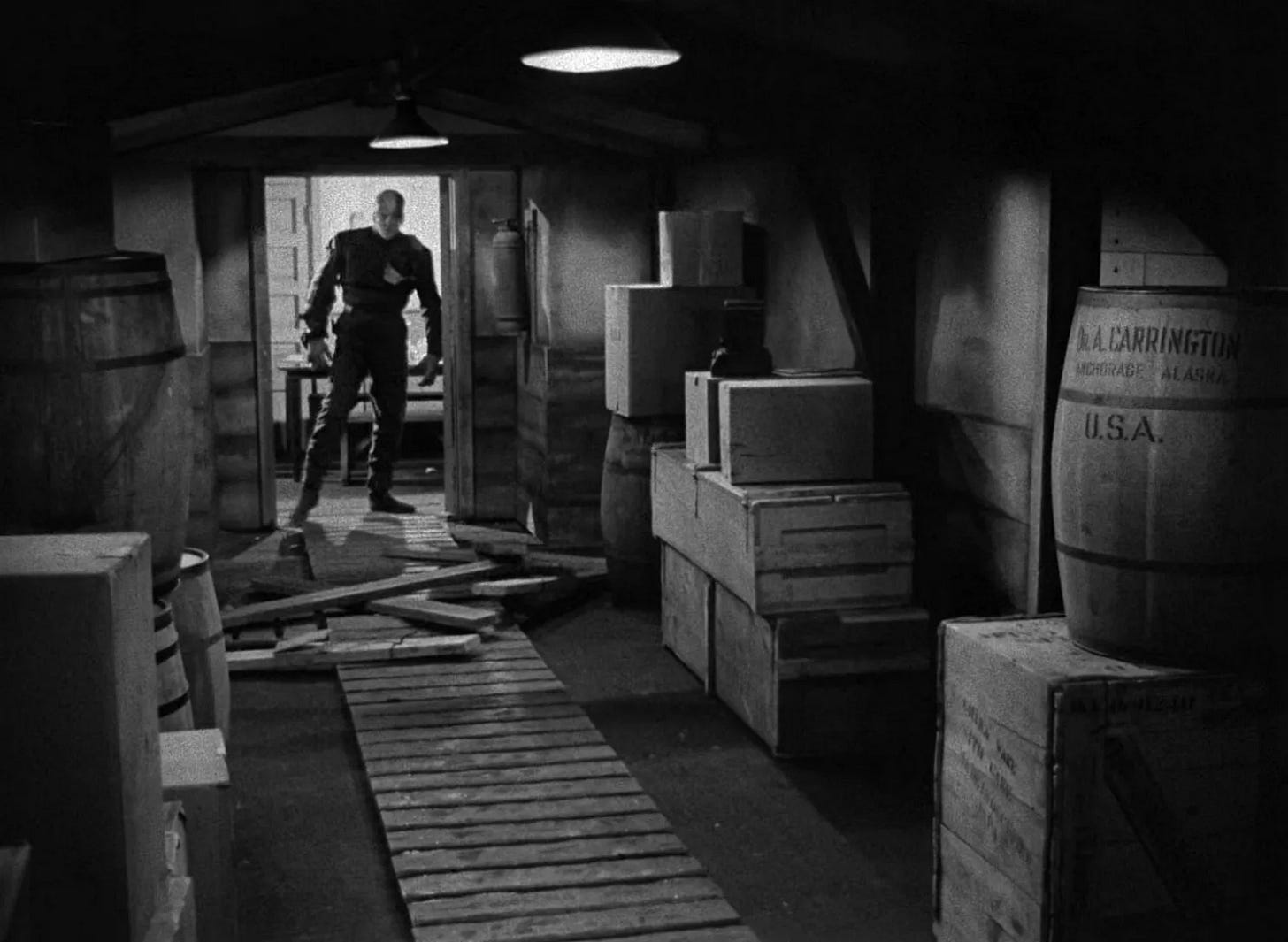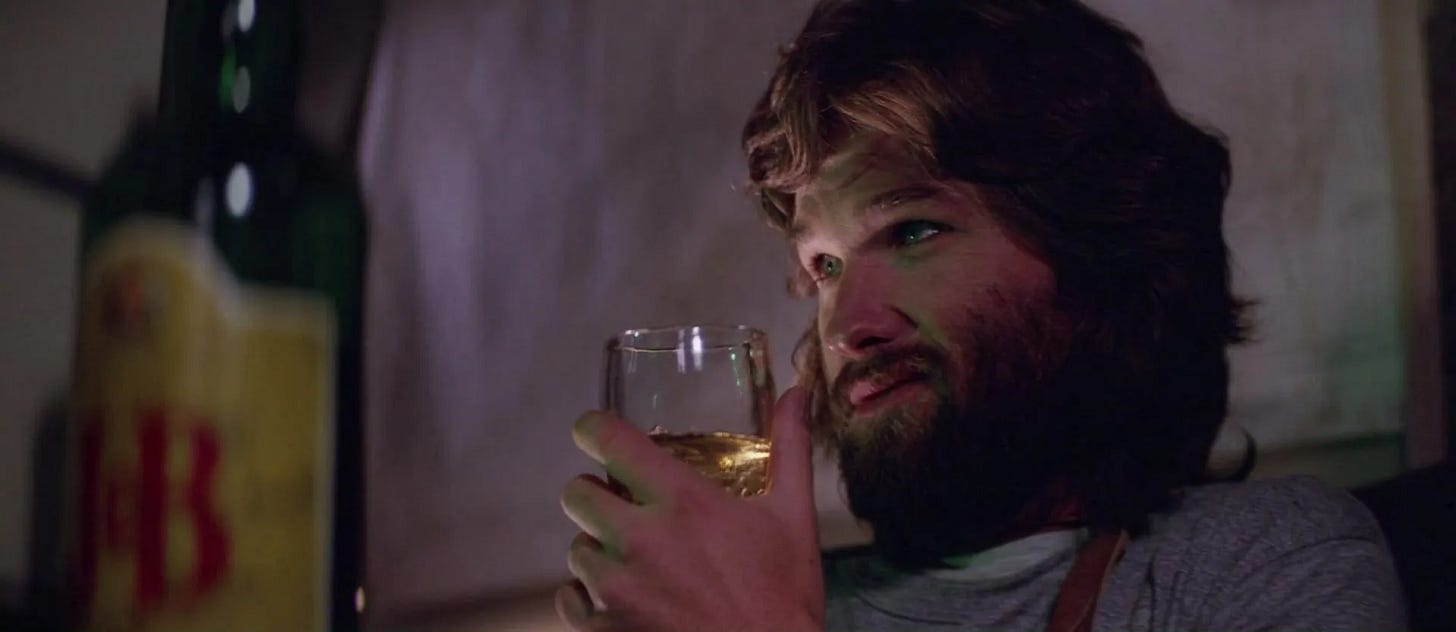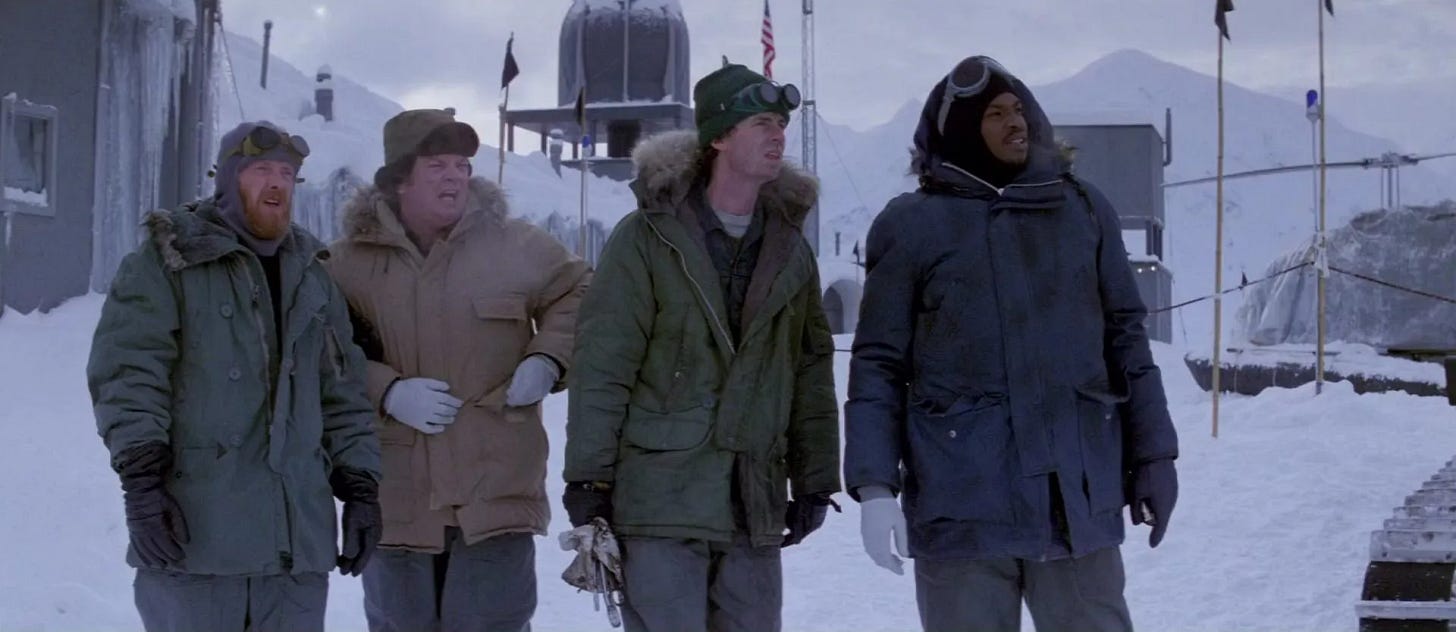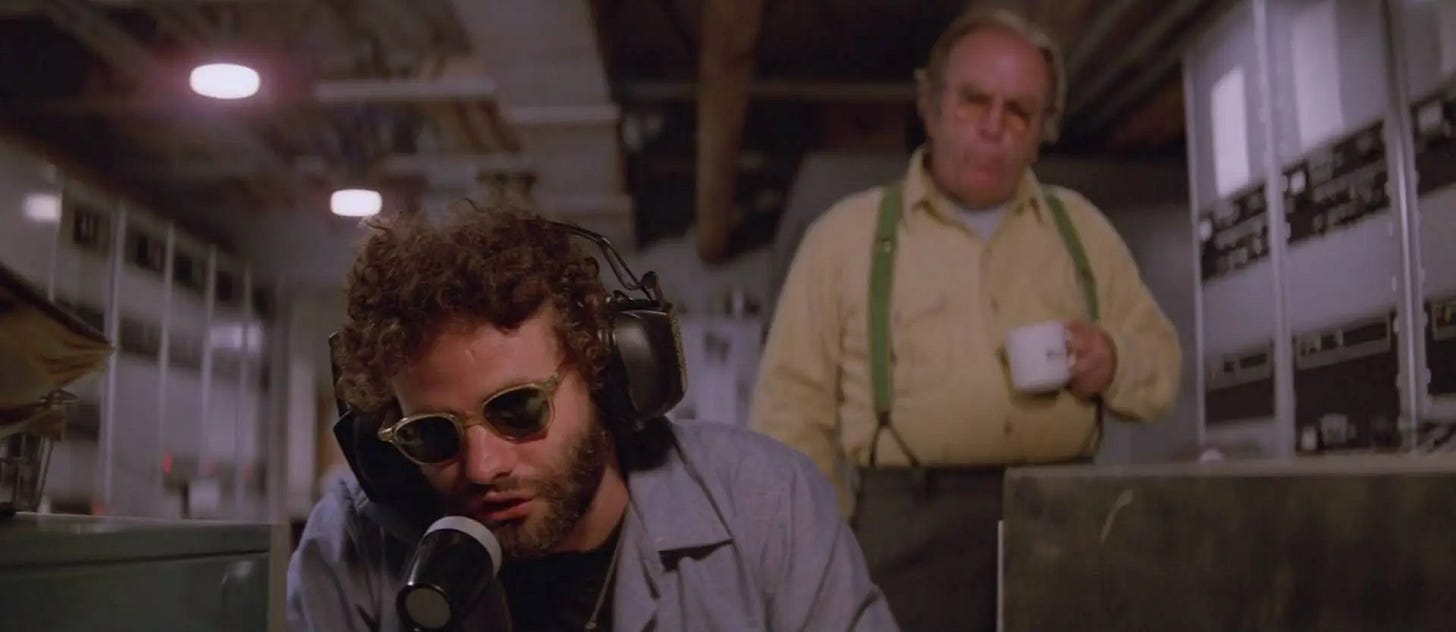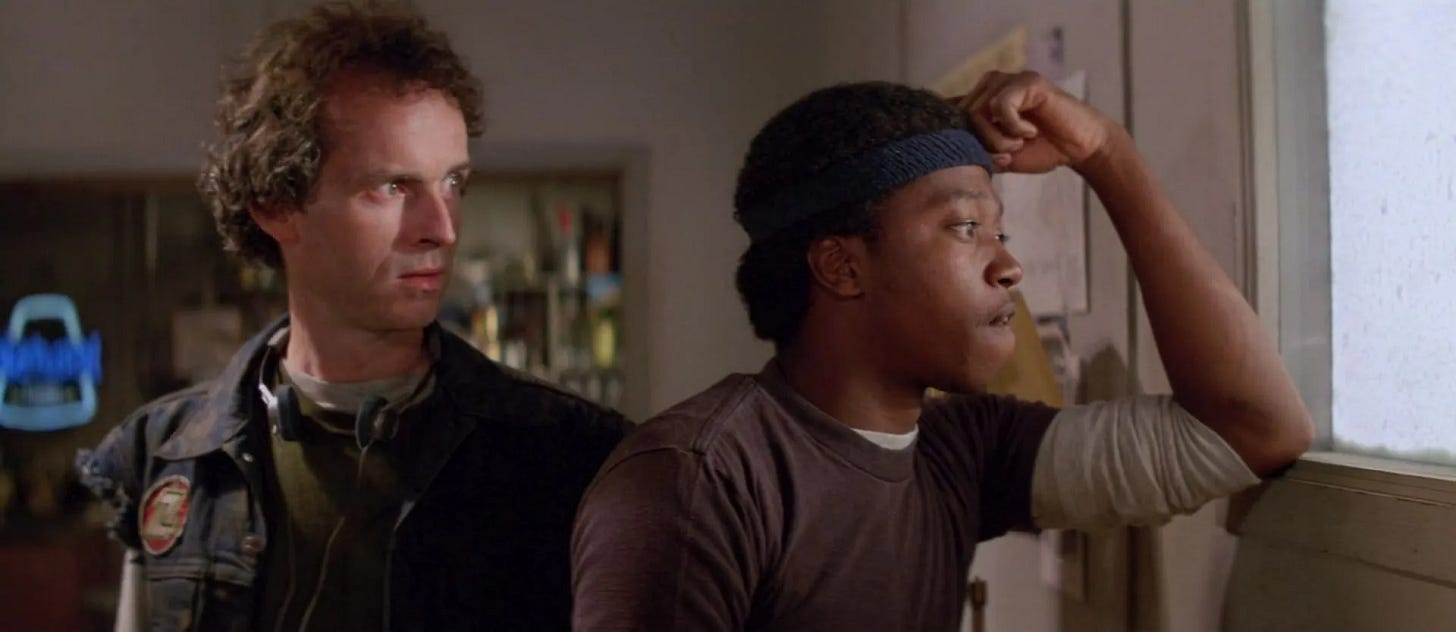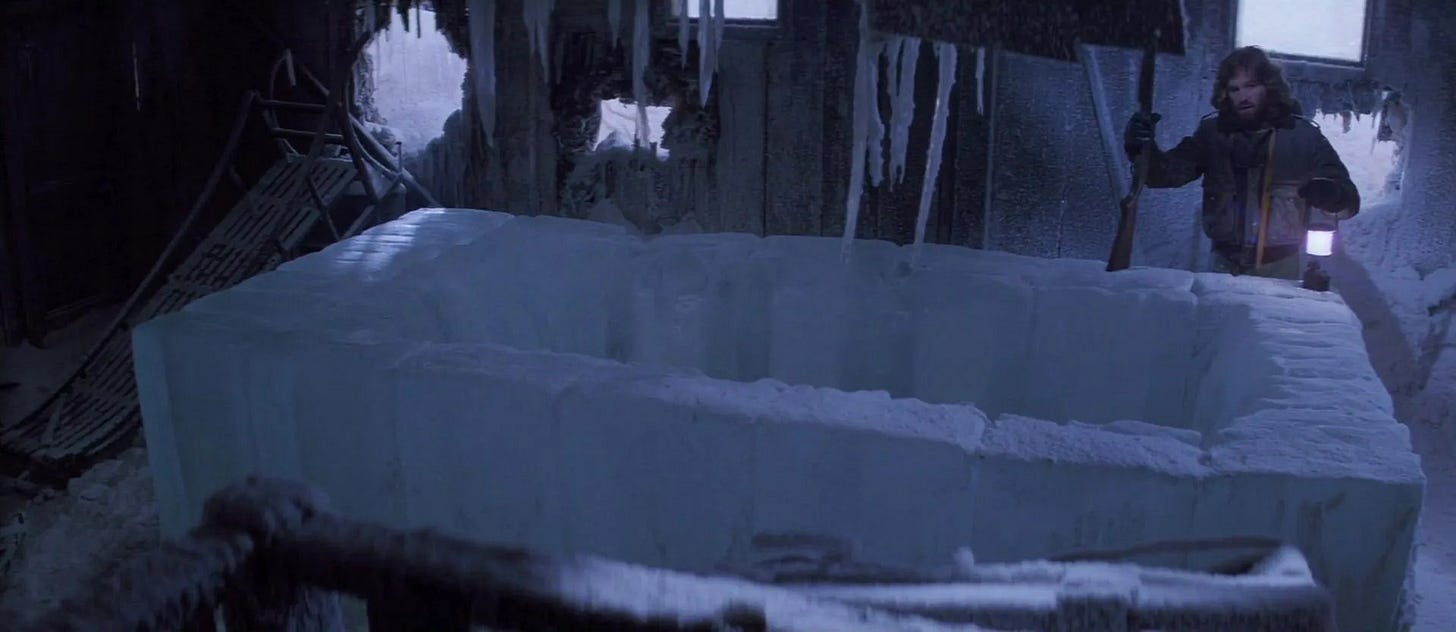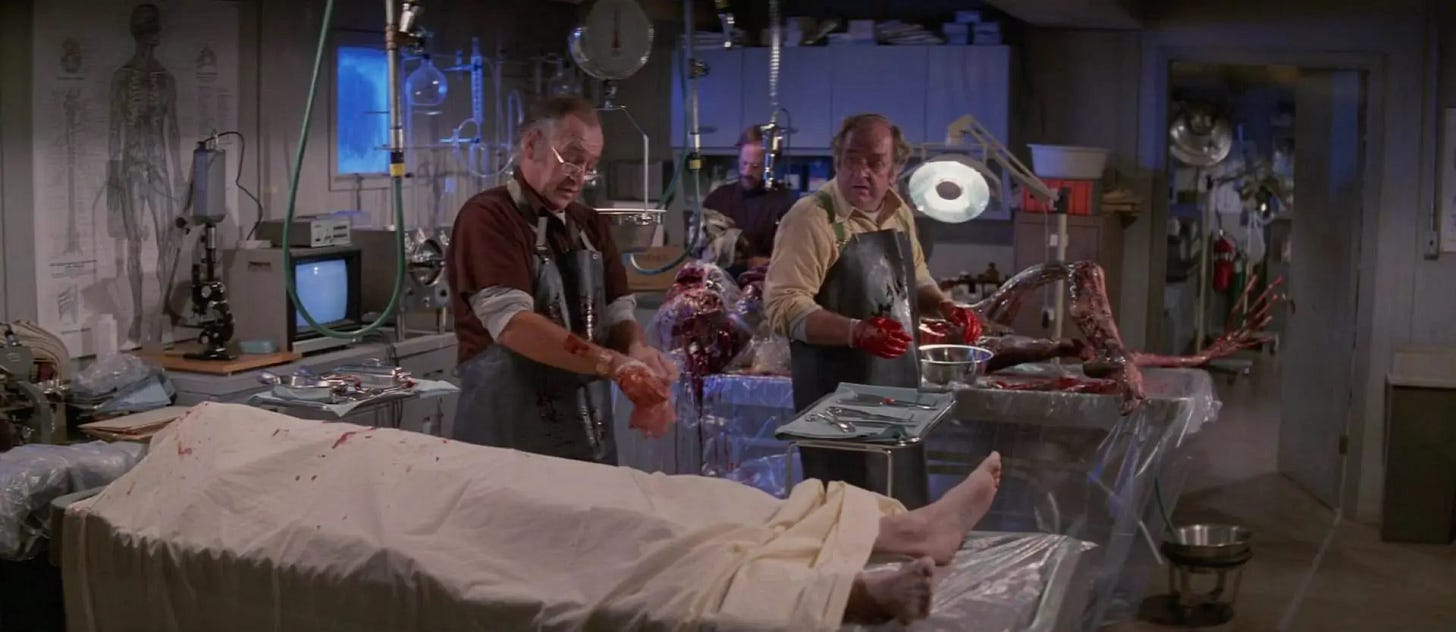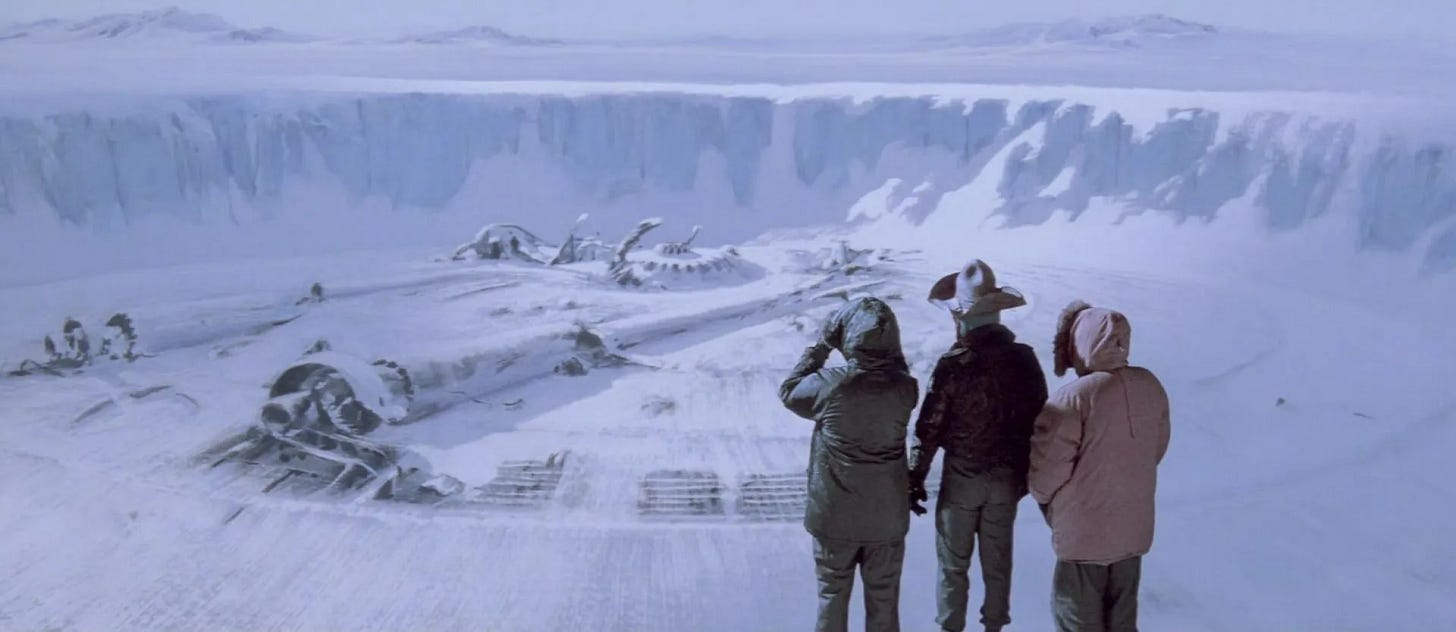The Thing (1982): Part 1 of 2
The pulps, Howard Hawks, adapting junk, and faking Antarctica
In the month of October, Video Days is looking out for scaredy cats, counting down to All Hallows’ Eve with seven horror movies in ascending scariness.
THE THING (1982) is set on the far side of the world, yet unfolds with a horrible sense of dread that we’re witnessing the end of times. Watching or rewatching this master craftsmanship of science fiction and horror is similar to being locked in a room with an anaconda. Taking its time, the beast begins to push us into a corner. With nowhere to run, the realization we could not only be goners but devoured creeps in. Instead of a movie about an anaconda, this classical, highly skilled production is about paranoia, and how much worse it would be in the end to lose our ability as humans to trust anyone.
John W. Campbell Jr. was born in Newark, New Jersey in 1910, growing up there and in the nearby township of Maplewood. His mother had an identical twin, and the sisters would sometimes play a prank on Campbell, trading places before he returned from school (if true, this might explain why he fostered a paranoia that people were not who they appeared to be). Campbell attended a prep school he did not graduate, was accepted to MIT in 1928, but dropped out after one semester, and attending Duke University, was a mediocre student. He started submitting material to Amazing Stories magazine, favoring hard science fiction tales that had some basis in credibility. Campbell’s first published work, When the Atoms Failed, made the January 1930 issue. His factory-setting writing style evolved with his marriage to Doña Louise Stewart Stebbins. To inaugurate a deeper, more introspective type of story from the ones familiar to editors, Campbell adopted a pseudonym–Don A. Stuart–spun off from his wife’s name.
In 1937, Campbell accepted the job as editor-in-chief of Astounding Stories magazine, which he rebranded Astounding Science Fiction. Harboring a genuine love for the fiction he was curating, Campbell discovered L. Sprague de Camp, Robert Heinlein and Leigh Brackett, and would publish L. Ron Hubbard, Theodore Sturgeon and Issac Asimov early in their careers. In August 1938, Campbell published a story he’d written as Don A. Stuart, titled Who Goes There? It concerned a team of two dozen men stationed at a research station in Antarctica. They discover an extraterrestrial craft buried in 20 million years of ice and remove the corpse of its pilot. Eager to conduct tests, the team awakens the specimen, which has three red eyes and blue hair like slithering worms. Their attempts to isolate it fail, and they learn too late that the alien can imitate any lifeform it devours, leaving the probability that one or more of the men aren’t who they appear to be. Who Goes There? proved popular with readers of Astounding Science Fiction and reached more readers in 1946, when picked for inclusion in the Random House science fiction anthology Adventures In Time and Space edited by Raymond J. Healy and J. Francis McComas, and in 1948 as a novelette published by Shasta.
Director Howard Hawks was stuck in Heidelberg, Germany–or what the Allies had rebuilt of Heidelberg–in the summer of 1949 shooting exteriors for the comedy I Was A Male War Bride (1949) starring Cary Grant. According to legend, Hawks was browsing the Army PX and picked up a copy of Who Goes There? (it’s just as, if not more likely, that anyone who knew Hawks and his work read the novelette and passed it to the director). Howard Winchester Hawks had directed a great film in one of nearly every genre, from a gangster picture with Scarface (1932), the screwball comedies Twentieth Century (1934), Bringing Up Baby (1938) and His Girl Friday (1940), romantic melodrama in To Have and Have Not (1944), hardboiled crime with The Big Sleep (1946) and a western in Red River (1948). “Science fiction” didn’t exist as a film genre yet. Stories about flying saucers or spacemen were considered junk by most adults. Who Goes There? was different. Campbell’s hard science fiction contained staples favored by Hawks in action fare like Only Angels Have Wings (1939), in which rugged men (and a woman of equal mettle) work together in a remote outpost to solve a problem.
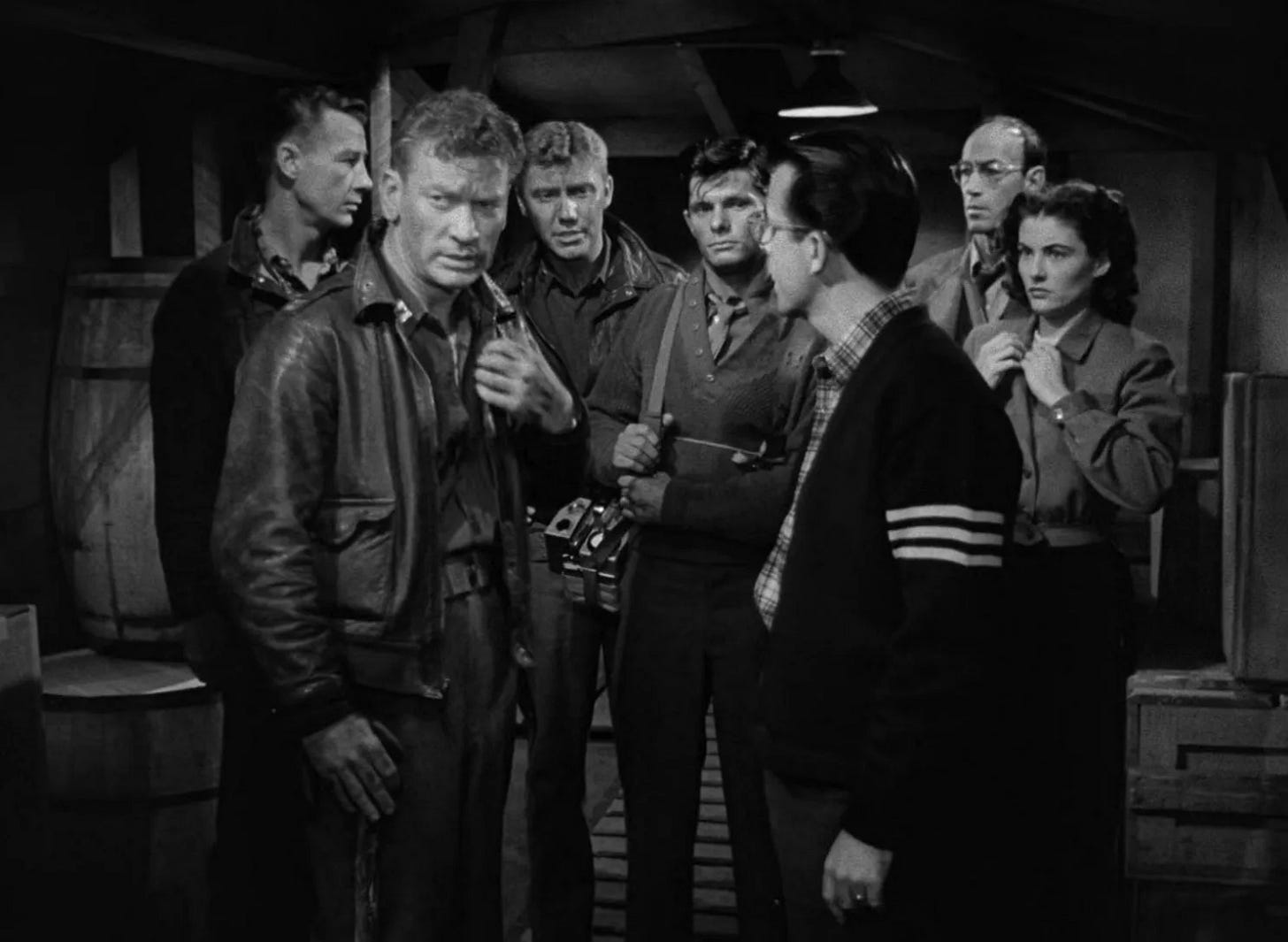
In June 1948, Hawks had signed a non-exclusive deal with Twentieth Century Fox to direct four pictures over the next six years, beginning with I Was A Male War Bride. Hawks had only produced without directing once, on a war movie titled Corvette K-225 (1943) starring Randolph Scott, but realizing he could only direct every nine months, was open to supplementing his income with a producer’s fee. In May 1950, Hawks made a pact with RKO Pictures to produce/ direct two films and produce a third of his own choosing over the next twenty-seven months under his own production company, Winchester Pictures Corp. Having optioned the film rights to Who Goes There?, Hawks commissioned loyal screenwriters Charles Lederer and Ben Hecht to generate a screenplay. For a director, Hawks selected editor Christian Nyby, who’d cut To Have and Have Not, The Big Sleep and had triaged Red River, transforming what Hawks and Nyby agreed didn’t work into one of John Wayne’s best westerns. Hawks selected a cast for what was now titled The Thing, promoting a day player from I Was A Male War Bride named Kenneth Tobey and an ingénue Hawks had hoped to make a star in Red River named Margaret Sheridan, before she bowed out to have a baby, as the film’s leads.
Traveling in a straight line, Charles Lederer (receiving screenplay credit) and Ben Hecht (uncredited) had replaced the shape-shifting alien of John W. Campbell’s story with a lumbering, Frankenstein’s Monster which drained victims of their blood, off-screen, of course. James Arness (6’7”) was cast as the Thing, one of many movie monsters played by tall men. Christian Nyby had not only worked for Howard Hawks and studied the oeuvre of Howard Hawks, but availed himself of his producer for suggestions on how to do things, like set up a shot. This led proponents of the auteur theory to conclude that Hawks had directed the picture himself, a claim the producer denied in the media, but scholars or film buffs kept alive. Released in April 1951 as The Thing From Another World–to avoid association with a novelty tune titled “The Thing” that was trendy at the moment–the film was promoted as the first of its kind, a “science fiction thriller.” It was the first movie from a major studio about alien invasion, and with the public gripped in the nascent stages of UFO hysteria, terrified many who went to see it. The Thing From Another World was re-released theatrically in 1954 and 1957, and played on television regularly in the 1960s and ‘70s.
Stuart Cohen — who’d recently attended USC School of Cinematic Arts, and was an associate producer on the TV movie Sarah T. — Portrait of a Teenage Alcoholic (1975) starring Linda Blair — had read Who Goes There? when he was twelve years old and always felt it held fantastic untapped potential for a movie. In late 1975, he pitched a faithful adaptation to David Foster, a former publicist for Steve McQueen who’d been a producer on McCabe and Mrs. Miller (1971) and The Getaway (1972). With Lawrence Turman, Foster had co-founded the Turman-Foster Company and secured a development deal with Universal Pictures. David Foster saw the same potential in the John W. Campbell story that Cohen did. The film rights had exchanged hands for a while. Hal Barwood & Matthew Robbins had optioned them, and when available, Universal picked the property up for Turman-Foster to develop. To cover their bases, Universal also optioned the remake rights to The Thing From Another World from a producer named Wilbur Stark, who’d snapped up rights to a list of features from RKO Pictures, pitching remakes of movies like I Walked With A Zombie (1943) or Out of the Past (1947) to anyone buying.
Cohen preferred to keep the title Who Goes There?, but Universal, a monster movie factory if Hollywood had one, mandated The Thing. Cohen’s first choice to write and direct was John Carpenter, a friend from USC who’d talked arduously about the Howard Hawks production, as well as the novelette, which Carpenter had discovered as an adolescent and noted was very different from the movie. At twenty-seven years of age, Carpenter had co-written, produced, directed and scored the music for Dark Star (1974), a science fiction picture which qualified as either the most ambitious student film of all time, or one of the lousiest theatrically released films ever, depending on one’s sense of humor. Universal didn’t consider Carpenter a serious candidate to tackle The Thing, preferring someone with experience, ideally under contract to the studio, like Tobe Hooper & Kim Henkel, who’d written The Texas Chainsaw Massacre (1974) with Hooper directing. Hooper & Henkel were fans of The Thing From Another World, but unlike Carpenter, weren’t interested in Campbell’s study of assimilation and paranoia. The duo dashed off a screenplay before a pending WGA strike in 1977. Cohen recalled the Hopper & Henkel script as being a sort of Antarctic Moby Dick, with a captain battling a big monster. The producer summarized their draft as “dense, humorless, almost impenetrable (the word John used when he later came on board was incomprehensible).”
Foster and Cohen took a meeting with John Landis, who was on the Universal lot and in post-production on National Lampoon’s Animal House (1978), but wasn’t interested in remaking The Thing. The studio held a New York author/ playwright named David Wiltse in high regard, hiring him to do rewrite work. Turman-Foster commissioned Wiltse to write a new script, which Cohen summarized as a poor match between material and writer. Universal next tried Logan’s Run co-author William F. Nolan to take a pass at The Thing. Nolan completed a treatment that no one wanted to move forward on. All three attempts had ignored John W. Campbell’s shape-shifting alien and the paranoia it would unleash on an isolated group, favoring the sort of monster movie that Charles Lederer & Ben Hecht had ripped through. By May 1979, two things had changed. A science fiction horror film about an alien unleashed in a claustrophobic setting titled Alien was a blockbuster. It was a serious take on Dark Star originated by that film’s co-writer, special effects supervisor and star, Dan O’Bannon. Secondly, John Carpenter had co-written, directed and composed the music for his first horror movie, Halloween (1978), which grew into the most profitable independent film of all time. In July, Carpenter wrapped production on his next feature, The Fog (1980), and Universal was open to retaining him.
Flush with success, John Carpenter was dubious about taking the job. In an interview with Creative Screenwriting magazine in 2014, Carpenter recalled, “Stuart Cohen, a friend of mine from USC, said we’re going to remake it, and the idea of trying that was terrifying. The monster wasn’t any great shakes in it, but the whole stylistic approach … you just can’t touch that, and I was afraid to try. So he suggested I read the short story and see what I thought, and it was Agatha Christie’s Ten Little Indians in many ways, but it was the creepiness of the imitation business and the questions that it brought up that I thought were really interesting. I also thought it was timely, that in remaking the short story I could be true to my day making this movie, just like Hawks was true to his day when he made his. And there was something else, that whole ‘who goes there?-- it was a spooky idea.” Carpenter had been working on an original screenplay titled The Philadelphia Experiment and after what he considered two great acts, hadn’t been able to figure out the third. Anxious he might encounter similar resistance with The Thing, Carpenter preferred the script be tamed by another writer.
Reaching for one of top science fiction writers in Hollywood, Turman-Foster put a call out to Richard Matheson, whose agent seemed to regard the project as a junky pulp novel. Screenwriters Deric Washburn (The Deer Hunter) and Ron Koslow (Lifeguard) were among those who agreed to an interview. Some exhibited similar disdain for the material, while others were wary of following it. Cohen proposed meeting with Bill Lancaster, author of The Bad News Bears (1976) and solely credited for its abominable second sequel, The Bad News Bears Go To Japan (1978). Cohen was struck by the finesse Lancaster had drawn an ensemble with, even if it was a comedy about pee-wee league softball. Lancaster was not overly enthusiastic about the novelette, but was the first writer to recognize that the biggest threat to the men might not be an alien, but each other. Carpenter, attached to direct pending his approval of a script, endorsed Lancaster to adapt Who Goes There? David Foster believed in keeping its ensemble male, which Carpenter agreed would streamline things. Lancaster was left to determine how many men. He wrote thirty pages and shared them with Carpenter, Foster, Turman and Cohen. The latter credited those pages as being the first thirty minutes of The Thing.
As Carpenter feared he might himself, Lancaster struggled to finish the script, and it was close to a year, in the fall of 1980, before the screenwriter had a draft to share. Carpenter called it the best script he’d ever read, and invited Lancaster to the filmmaker’s Marin County retreat in Inverness for a weekend to talk everything over. Dated March 4, 1981, Lancaster’s second draft incorporated notes from Carpenter and brainstorms with Cohen. The associate producer made a presentation of delivering the script to Universal Pictures president Ned Tanen, hiring actors in parkas and snowshoes to carry a copy to Tanen in a cooler filled with dry ice. Validating their high appraisal of Lancaster’s script, Tanen offered no notes. The filmmakers received zero resistance from Universal over the male ensemble, or the ending, which left victory over the alien ambiguous. When the time came for Tanen to meet with the filmmakers to greenlight The Thing for production, Carpenter surprised everyone when he announced that a western he’d written titled El Diablo was pending a green light from EMI, at a considerably lavish budget of $25 million. Carpenter would also retain a good deal of creative autonomy and reunite with producer Debra Hill for their fifth picture together.
In search of a replacement, Cohen suggested to Foster they consider Sam Peckinpah, director of The Getaway and who Foster knew maybe too well. Though renowned for male ensembles, Peckinpah was known to be in declining health, and had barely finished his last picture, Convoy (1978), with no work since. Foster did reach out to Walter Hill, screenwriter of The Getaway, and director of excellent male ensembles in The Long Riders (1980) and Southern Comfort (1981) who’d rewritten and produced Alien as well. Hill passed. The Thing might have perished if EMI had made good on its promises to Carpenter, but in 1980, westerns had fallen out of vogue. That fall, Carpenter signed to direct The Thing, his first studio assignment. Universal proposed a production budget of $8 million. This was $2 million more than Carpenter made his previous picture for, the futuristic Escape From New York (1981). It was also the budget John Landis had on his monster movie, An American Werewolf In London (1981). Art director Dave Kuipers was contracted to design the Thing, drawing from descriptions in Lancaster’s screenplay for an alien that fully revealed itself in the climax.
To serve as director of photography, Carpenter retained Dean Cundey, who’d lit Halloween, The Fog and Escape From New York. Lighting Rock ’N’ Roll High School (1979), Cundey had met a barely legal makeup artist named Rob Bottin who’d introduced himself as a big fan of Halloween. Cundey brought the kid to meet John Carpenter, who, won over by Bottin’s enthusiasm, offered him a role as one of the ghosts in The Fog. Bottin graduated to create the makeup effects for The Howling (1981), earning as associate producer credit as well. Meeting with Carpenter to discuss The Thing, Bottin’s take was that the alien didn’t have to be one creature jumping from man to man. As in John W. Campbell’s story, the Thing could take the form of anything across the universe it had imitated. The director dispatched Bottin to work with a conceptual artist at Universal named Michael Ploog, who Bottin knew as an illustrator for Marvel Comics titles like Werewolf By Night and Ghost Rider. Several weeks later, Bottin returned to Carpenter’s office at Universal with Ploog’s storyboards, which they pinned to the wall to appraise.
Carpenter wanted the special effects for The Thing to be shot live in front of the camera, “like a magic show.” He asked Bottin if he could build these creatures and operate them to do the things they were doing on the storyboards, and assured Bottin could, he hired the 22-year-old to create the makeup effects for The Thing. Stuart Cohen was able to raise Bottin’s makeup effects budget from $200,000 to $750,000. This forced Carpenter to trim costs to a budget that was already too rich for the studio’s taste. Production designer John Lloyd, who under contract to Universal had built the sets for The Blues Brothers (1980), confirmed that instead of building the Norwegian camp, they could reuse the set for “U.S. National Science Institute Station 4” after they blew it up. As scripted, the meteorologist Bennings was to meet his fate when he joins pilot MacReady and mechanic Childs in pursuit of the escaped kennel dogs by helicopter. Bennings was to be grabbed by the Thing and pulled under a lake of ice, where he pops up in various stages of assimilation. The sequence was scrapped. The character of Nauls, the cook, was to encounter what the production referred to as the Box Monster, with the Thing popping out of a crate, but Bottin’s team could never figure out how to do this with the money available. Cohen chalked these scenes up to a $25 million version of The Thing that never made it past the script stage. Universal set a production budget of $14 million, which ended up closer to $15 million, Bottin’s makeup effects budget doubling to $1.5 million.
In January 1981, John Lloyd was assigned the task of faking Antarctica. Colorado, Utah and Montana (where the crew of The Thing From Another World had waited in vain for snow on the ground) were rejected due to weather forecasts that predicted uncommonly dry winters. Lloyd located a knoll atop a glacier in the vicinity of Stewart, British Columbia accessible by a (rough) one-lane mining road, with lodging for cast and crew within commuting distance. Far more remote was the tundra where the opening sequence would be shot. Dr. Maynard Miller, who ran the Juneau Icefield Research Program at the University of Idaho and supervised access to a glacier near Juneau, Alaska, agreed to accommodate a crew of fifteen at his camp for a week and a half. He served as communications officer, CB radio being their only contact with civilization in 1981. Both the location and the camera equipment of the time prohibited Carpenter from viewing any of the footage he was shooting in Alaska. Dailies would have to be sent down the mountain by helicopter, weather permitting, and the results spoken to him. Back in Los Angeles, editor Todd Ramsay reported a spot on the lens he thought rendered the first two days of shooting unusable. With Southern Californians, several who had nicotine habits, already exhausted by working on ice and Dr. Miller forecasting bad weather, Carpenter wanted a second opinion before he reshot anything. They had at their service Verna Fields, editor of Jaws (1975) who was a VP of production at Universal. Fields deemed the footage usable, and what Stuart Cohen classified as a “grayish elliptical dot in the lower right third of frame” was briefly seen in the original prints, and on early videocassette or laserdisc versions of The Thing, but has long since been digitally corrected.
Continue with Part 2 of 2 here.
Video rental category: Horror
Special interest: Staff Picks
Thanks to Stuart Cohen and his blog The Original Fan for exhaustively detailing the production history of The Thing (1982).


